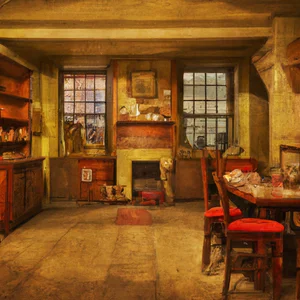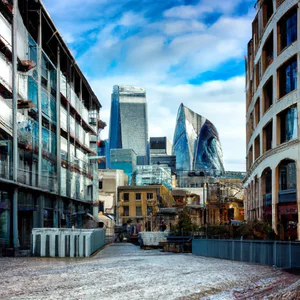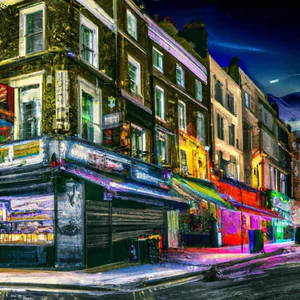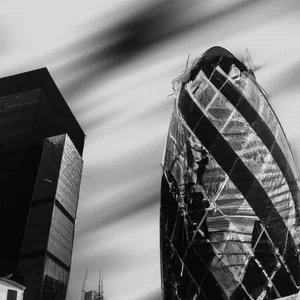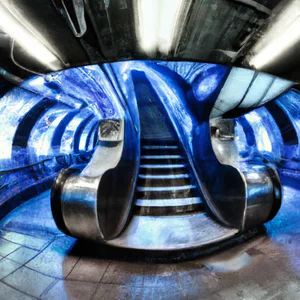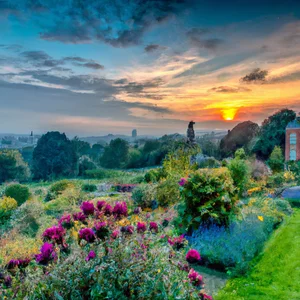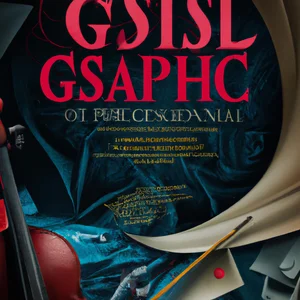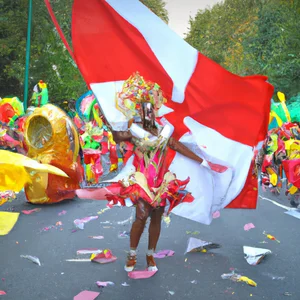Book your experience
Docklands: From maritime history to London's high-tech future
Docklands: from a seaside past to a super technological future in London
So, let’s talk a bit about Docklands, which is a truly fascinating place. If you think about it, in the past it was a real maritime hub, full of ships, goods and people running from one side to the other. I remember that I once visited an old warehouse, and it seemed like we had gone back in time, with those thick walls and wooden beams that told stories of sailors and trade. It’s crazy to think how much everything has changed.
Today, Docklands is almost unrecognizable! It’s like they took an old storybook and rewrote it with a futuristic ending. Skyscrapers that touch the sky, shiny offices and technology that makes your head spin. I don’t know, maybe it’s a little too much, but it’s impressive to see how things have evolved.
Once, I went there with a friend, and we walked along the river. There was a spectacular view, with the new buildings reflecting in the water, and I said to myself, “Man, who would have thought there was all that maritime history here?” It’s as if the sea has left its mark, but now it’s a whole other world.
In short, on the one hand, I understand that this development brings with it advantages, such as jobs and innovation. But, on the other hand, I wonder if we aren’t losing a bit of that historical soul. I think there needs to be a balance, a way to keep alive the memory of what was, while looking to the future. Maybe they could do some event that recalls maritime history, I don’t know, some sort of party, what do you think?
In any case, Docklands is a prime example of how a city can reinvent itself. And, who knows, maybe one day I’ll go back and discover other wonders that I hadn’t noticed. Life is a constant change, and Docklands is proof of this.
Docklands’ maritime origins revealed
When I first visited Docklands, I found myself walking along the River Thames, immersed in an atmosphere that seemed to tell stories of ships and trade. As I watched the modern vessels plying the waters, I couldn’t help but think about how this place was once the beating heart of London’s maritime trade. My attention was caught by an old pier, where the wooden planks creaked, as if they wanted to reveal secrets of a bygone era.
A dive into history
Docklands’ origins date back to the Industrial Revolution, when the River Thames became a major artery for global trade. Local authorities, such as the Port of London Authority, documented how this area was a nerve center for the importation of goods such as tea, coffee and spices, which arrived from every corner of the world. This maritime past is not just a historical curiosity; it is an integral part of Docklands’ cultural identity. Today, the Museum of London Docklands offers a fascinating exhibition of this history, with artefacts and stories that bring the golden era of London’s ports to life.
A little-known tip
If you want an experience that few tourists know about, I recommend visiting Surrey Docks Farm, an urban farm located just a short walk from the historic docks area. Here, you can immerse yourself in a rustic atmosphere, meet animals and participate in gardening workshops, a perfect way to understand how the local community is trying to reconnect with nature, even in an urban context.
Cultural heritage
Docklands’ maritime heritage has had a profound impact on local culture. The neighborhood has always attracted artists and entrepreneurs, inspired by its vibrant history. Street artists and art installations along the river narrate the transformation of this space, from a crowded port to an innovative and technological center. The maritime history of Docklands is, therefore, not just a tale of the past, but a foundation for the future.
Sustainability and responsibility
In an age where sustainability is key, many projects at Docklands focus on eco-friendly practices. For example, the Greenwich Peninsula is an example of sustainable development, with buildings designed to reduce environmental impact and public spaces designed to encourage biodiversity. By visiting these areas, tourists can contribute to a model of responsible tourism.
An experience not to be missed
Don’t miss the chance to take a cruise on the Thames. There are numerous companies, such as Thames Clippers, who offer panoramic tours, allowing you to see the London skyline from a unique perspective. As you travel, listen to stories told by expert guides, who will take you through centuries of history.
Final reflections
Many consider Docklands only as a modern and technological area, forgetting that its roots lie in a rich and fascinating maritime history. The next time you find yourself walking along the river, ask yourself: what stories could these waters still tell? Discovering these origins could prove not only educational, but also deeply inspiring.
Urban renewal: a tour of futuristic architecture
When I first set foot in Docklands, my attention was immediately captured by its astonishing architecture. One sunny afternoon, as I crossed the bridge over the Yarra River, I was struck by a skyscraper that almost seemed to float in the air, its blue and silver reflections dancing on the surface of the water. This is just a taste of the magic that Docklands urban renewal has to offer.
A journey between innovation and design
The Docklands urban renewal is a clear example of how contemporary architecture can transform a previously industrial space into a vibrant urban centre. From iconic buildings like the Darebin Intercultural Centre to eco-sustainable residential structures, every corner tells a story of innovation. According to the Melbourne Docklands Authority, the regeneration project gained traction in the 1990s, leading to a renaissance that has welcomed residences, offices and public spaces.
An insider tip
A tip that few people know is to visit the Library at the Dock, an example of sustainable architecture that houses a library, community center and event spaces. Here, not only will you find an inspiring environment, but you can also participate in free events and workshops that highlight local art and culture.
The cultural impact of renewal
Urban renewal has had a profound impact on Docklands, not only architecturally, but also culturally. The area has become a crossroads of creativity, where local and international artists meet and where events such as the Melbourne International Comedy Festival find their home. This fusion of cultures and ideas has created a unique atmosphere that attracts visitors from all over the world.
Sustainable tourism practices
In an age where sustainability is key, Docklands stands out for its eco-friendly practices. Many buildings are designed with recycled materials and renewable energy systems. During your tour, look out for the green spaces that dot the area, such as Docklands Park, which offer a natural refuge amidst urbanization.
An unmissable experience
I recommend taking part in a guided architectural walk, where you can discover the hidden details of Docklands’ most emblematic structures. These tours will not only provide you with a unique perspective on architecture, but will also allow you to interact with local experts who will share anecdotes and curiosities.
Myths to dispel
A common misconception is that Docklands is just one area lifeless commercial. In reality, the neighborhood is a vibrant mix of homes, offices and public spaces, full of cultural activities and entertainment. This limited perception doesn’t do justice to the wealth of experiences Docklands has to offer.
Final reflection
As I walk among the futuristic architecture of Docklands, I can’t help but wonder: how can urban renewal continue to shape the cities of the future? The transformation of Docklands is just one example of how innovation and sustainability can go hand in hand. And you, how do you imagine the future of the cities you love?
Navigate the historic waters: boats and river tours
A personal experience
Walking along the banks of the river that runs through Docklands, I vividly remember the feeling of freedom as I boarded a boat preparing to set sail. The fresh morning air mixed with the salty smell of the water, creating an almost magical atmosphere. That morning, I would not only discover the beauty of the landscape, but also the history of an area that, for centuries, has lived thanks to its waters.
Practical information
Docklands river tours are operated by several local companies, including Melbourne River Cruises and Spirit of Melbourne. These boats offer a unique opportunity to explore the city from a different perspective. Departing regularly, tours typically last an hour to an hour and a half and feature engaging narratives about the history and architecture along the river. I advise you to book in advance, especially on weekends, to guarantee yourself a place on the panoramic terrace, the ideal place for taking unforgettable photos.
An insider tip
A little secret that many tourists don’t know is the possibility of taking part in river tours at sunset. This time not only offers spectacular light for photos, but also a more intimate and peaceful atmosphere. During these cruises, you may even spot some of the local bird species that populate the river banks, an experience that further enriches your trip.
Cultural and historical impact
The waters of Docklands are not just a scenic element; they are a symbol of the city’s maritime history. Originally a port area, Docklands has seen the passage of merchant ships and cargo boats, contributing to Melbourne’s economic growth. Today, these river tours serve not only as a tourist attraction, but also as a reminder of the resilience and evolution of this area.
Sustainable tourism
Many of the river tour companies are committed to responsible tourism practices, using electric or hybrid boats to reduce environmental impact. Choosing these tours is a way to enjoy the natural beauty of Docklands, whilst respecting the environment.
Immerse yourself in the atmosphere
Imagine being on board, with the sun setting on the horizon and the water lighting up with golden reflections. The chatter of the passengers mixes with the sound of the waves, as the boat glides gently along the river. Every corner reveals a piece of history, from Melbourne’s historic architecture to its impressive modern skyline.
An activity worth trying
After the tour, don’t miss the opportunity to stop at one of the many riverside cafes, such as the Cargo Restaurant, to enjoy an artisanal coffee and a slice of homemade cake. It’s the perfect way to end a day of exploration.
Clear up misunderstandings
A common myth is that river tours are only for tourists. In fact, many Melbourne residents use these boats as a daily means of transport, proving that the beauty of the river is appreciated by those who live here, not just those who visit.
A final reflection
As the boat continues to glide through the water, you can’t help but wonder: How many stories are hidden beneath the surface of these waters? The next time you find yourself in Docklands, take a moment to reflect on what these stories might tell you.
Local culture: Docklands markets not to be missed
The first time I set foot in one of the Docklands markets, I was captivated by the bright colors and intoxicating scents wafting through the air. One sunny afternoon, I found myself at South Docklands Market, where local artisans displayed their creations alongside food producers offering samples of regional specialties. Between a bite of fresh bread and a cup of artisanal coffee, I realized that markets are not simply places of exchange, but real pulsating centers of culture and community.
Discover the Markets
Docklands is famous for its variety of markets, each with its own distinctive personality. The Victoria Harbor Market is known for its organic produce and local delicacies, while the Docklands Sunday Market is a great place to find unique crafts and souvenirs. These markets not only offer a great opportunity to buy fresh produce, but also to interact with residents and learn about the stories behind each stand.
Insider advice
If you want a truly authentic experience, visit the market during the early hours of the morning. Not only will you have access to the best offers, but you will also be able to watch the preparation of fresh products, creating a direct connection with the sellers. A little-known trick is to ask artisans if they have any “deals of the day”; many of them are happy to offer special discounts on items they need to sell before closing.
Cultural and Historical Impact
Docklands Markets are not only centers of trade, but also an important cultural heritage. They reflect the maritime history of the area and the diversity of the local population. Today, the markets are a symbol of community and sustainability, promoting responsible purchasing practices and the use of local products.
Sustainability and Responsibility
Many sellers are engaged in eco-sustainable practices, such as the use of biodegradable packaging and the promotion of 0 km products. Choosing to purchase from these markets means supporting the local economy and contributing to a more responsible tourism model.
An Activity to Try
For an engaging experience, take part in one of the cooking classes held at the market. Here you can learn to prepare typical dishes using fresh, local ingredients. It’s a unique way to immerse yourself in the food culture of Docklands and return home with new culinary skills.
Myths and Misconceptions
A common misconception is that markets are only for tourists. In fact, residents flock to these places for their offerings and quality of products. The market is a meeting point for the community, where stories and traditions intertwine.
Final reflection
Every time I visit the Docklands markets, I ask myself: how many stories are hidden behind each product sold? These markets are a window into the daily lives of residents and an opportunity to connect with local culture in a meaningful way. Next time you’re in Docklands, take the time to explore these vibrant spaces and be amazed by their richness.
Sustainability at Docklands: a model for the future
A surprising encounter with sustainability
I still remember my first visit to Docklands, when, walking along the Waterfront, I came across a group of university students intent on planting trees. That scene was not just a voluntary action, but a tangible symbol of a collective commitment to a sustainable future. This moment affected me deeply, making me understand that Docklands is not just a place to visit, but a example of how communities can come together to tackle environmental challenges.
Local initiatives for sustainability
Docklands has made great strides in the field of sustainability, becoming a model for other cities. The Green Building Council Australia has recognized several buildings for their energy efficiency and use of sustainable materials. For example, Docklands Stadium was designed with cutting-edge technologies to reduce energy consumption. Additionally, rainwater harvesting has become a standard feature in many buildings, helping to maintain the city’s water levels.
An insider advises
If you want to live an experience that few tourists know about, take part in one of the tours organized by the Docklands Sustainability Initiative. These tours will take you to key locations to discover how the community is implementing sustainable practices, from recycling to community gardens. It is an unmissable opportunity to see concrete actions for sustainability up close.
The cultural legacy of sustainability
Docklands’ transition from an industrial area to a sustainable urban center is an example of resilience and innovation. In the 90s, this area was synonymous with abandonment and degradation. Today, it has become a symbol of how urban regeneration can occur in harmony with the environment, promoting a culture of ecological responsibility.
Responsible tourism practices
During your visit to Docklands, consider using public transport such as trams and bicycles. Not only will you reduce your carbon footprint, but you will also have the opportunity to explore the area in a more authentic way. Many local hotels are committed to eco-friendly practices, such as recycling and using local products.
An immersion in the atmosphere of Docklands
Walking around Docklands is like navigating a vibrant urban ecosystem. The air is filled with a mix of smells, from food cooked in the markets to the aromas of local cafés, while the sounds of water crashing against the docks accompany every step. Futuristic architecture mixes with green spaces, creating an atmosphere of harmony between man and nature.
An experience not to be missed
If you are in Docklands, don’t miss the opportunity to visit the Docklands Community Garden, a project that invites visitors to participate in workshops on sustainable farming. Here, you can learn ecological gardening techniques and maybe even take home some plants to grow.
Myths to dispel
A common misconception is that sustainability involves sacrifices in comfort and luxury. In fact, Docklands demonstrates that these two dimensions can coexist. Many restaurants and accommodations here offer high-quality experiences without compromising ecological principles.
A final reflection
As we travel, it is vital to consider our impact on the environment. Docklands invites us to reflect on how we can contribute to a more sustainable future, not just as tourists, but as global citizens. What sustainable practices will you take with you after visiting this extraordinary example of urban regeneration?
Authentic gastronomy: where to eat like a local
An experience that leaves its mark
I vividly remember my first encounter with Docklands cuisine. It was a fresh spring morning and I was at the Southbank market, surrounded by the enveloping scents of fresh fish and spices. A local vendor, with his melodic accent, convinced me to try a freshly prepared plate of fish and chips, with a crunchiness that only true experts can guarantee. This chance encounter transformed my perception of local gastronomy, showing me that Docklands is not just a transit area, but a true culinary paradise.
Where to find the best dining experiences
Docklands offers a wide range of restaurants and markets where you can enjoy authentic dishes. Among the places not to be missed are:
- The Fish Market: a must for fish lovers, where you can taste very fresh and local dishes.
- South Melbourne Market: here you will find not only street food but also fresh and artisanal products.
- Riverside cafes and restaurants: many of these offer spectacular views and seasonal menus that celebrate the best local ingredients.
A little-known tip
If you really want to eat like a local, I recommend visiting restaurants that are not found in tourist guides. One of these is Docklands Café, a small place that serves hearty breakfasts and dishes made with local ingredients. Here, locals gather to start the day with a classic Australian brekkie, featuring avocado, eggs and grilled tomatoes.
The cultural significance of local gastronomy
Docklands’ gastronomy is a reflection of its maritime history and cultural diversity. Over the years, the area has attracted a variety of communities, each bringing with them their own culinary traditions. This melting pot of cultures has given rise to a rich and varied gastronomic panorama, where each dish tells a story of exchanges and influences.
Sustainability and responsibility
Many restaurants in Docklands are committed to sustainability, using organic and local ingredients. An example is the Docklands Farmers’ Market, where local producers sell their products, creating a direct link between consumers and producers. Choosing to eat in these places not only supports the local economy, but also contributes to responsible tourism practices.
An immersion in flavours
Imagine sitting at a restaurant table overlooking the river, while the sun sets and the sky turns orange. A plate of fresh prawns, with a squeeze of lemon and a light spicy sauce, accompanies a glass of local wine. This is the essence of Docklands, a place where every bite is a journey through culture and tradition.
Recommended activities
For a complete culinary experience, I recommend joining a guided food tour, where you can taste different specialties in various restaurants and markets. This will not only allow you to try authentic dishes, but also to learn about the stories and people behind each establishment.
Myths and misconceptions
A common misconception is that Docklands is just a tourist and shopping area, lacking authenticity. Instead, the true soul of Docklands is found in its restaurants and markets, where locals gather to share a meal and tell stories.
Final reflection
After exploring the gastronomy of Docklands, I wonder: how often do we miss the opportunity to get to know a place through its food? The next time you visit a new destination, take the time to savor the local dishes, because each taste could reveal a piece of history and culture that would otherwise remain hidden.
Contemporary art: hidden galleries to explore
I remember the day I discovered one of the most fascinating art galleries in Docklands. I had decided to get lost among the alleys and converted warehouses, when, almost by chance, I came across a small exhibition space, The Docklands Gallery. The walls were adorned with bold works by local artists, and the atmosphere was vibrant, almost electric. This chance encounter opened my eyes to a side of Docklands that few tourists know about, a world of creativity pulsating beneath the surface.
Discover hidden gems
Docklands is a veritable treasure trove of artistic treasures, with a variety of galleries that escape the view of most. Among the most famous, the MELBOURNE ART FAIR offers a panorama of the scene contemporary, but it is in the lesser-known galleries that the true beating heart of art is found. Galleries like Art on the Dock and Canvas & Co. not only exhibit work by emerging artists, but also often host live events, where you can interact directly with the artists.
An insider tip
If you want an authentic experience, try visiting the No Vacancy gallery. This alternative space is famous for its provocative exhibitions and contemporary art workshops. A little-known tip: attend one of their opening nights, where you can meet the artists and discover the stories behind their works. Don’t forget to check their website for special events, as they can vary from week to week.
The cultural impact
Docklands’ art scene is a reflection of its historical evolution. Originally an industrial area, the neighborhood has undergone a profound renovation that has led to the creation of creative spaces. This has not only beautified the area, but also attracted artists and collectors, contributing to a cultural dialogue that continues to grow. Art is not just a decorative element here; it is an integral part of the social and cultural fabric of the community.
Sustainability and responsibility
Many Docklands galleries are committed to sustainability practices, using recycled materials in their installations and promoting artists who focus on eco-friendly themes. This approach not only enriches the artistic experience, but also contributes to a model of responsible tourism, encouraging visitors to reflect on the environmental impact of their choices.
An immersive experience
When you visit Docklands, don’t miss the chance to take a guided tour of the local galleries. These tours, often led by art experts, will allow you to discover works that may escape the attention of the casual visitor, and will offer you a unique perspective on the contemporary art scene.
Myths and misconceptions
A common myth is that contemporary art is distant or incomprehensible. In fact, many Docklands artists seek to engage audiences with interactive and accessible works. Don’t be afraid to ask questions or express your opinions; art is a dialogue, and every voice matters.
A final reflection
After exploring the galleries of Docklands, we invite you to reflect: how can art influence your perception of a place? Each work tells a story, and each gallery has the power to transform your tourist experience into a personal adventure. Which story will you take home?
An unexpected tip: discover the secret gardens
While walking along the banks of the River Thames, I came across a patch of greenery that seemed out of time. This small garden, hidden behind a renovated old warehouse, was a haven of tranquility, away from the hustle and bustle of the Docklands. Here, among exotic plants and colorful flowers, I discovered that the maritime past of this place is intertwined with its current evolution. That experience made me realize how important these green spaces are to the community, both from a historical and contemporary perspective.
The hidden beauty of the gardens
The secret gardens of the Docklands, such as Silo Park and Jubilee Park, are not only a refuge for residents, but also a tribute to the neighbourhood’s dockland history. These green spaces were designed to pay homage to the life that once animated these places, with small areas dedicated to native flora that recall the scents of the sea. According to a report by the Royal Horticultural Society, the presence of gardens and green areas in cities not only improves aesthetics, but also contributes to the well-being of citizens.
An insider tip
If you want to discover these secret gardens, I recommend you visit the St. Katharine Docks, where you will find hidden corners and peaceful walks. Here, you will not only have the opportunity to admire the natural beauty, but also to discover small cafes and boutiques that tell stories of the maritime past. Don’t forget to bring a book or notebook with you: these gardens are the ideal place to reflect and let your mind wander.
Cultural and sustainable impact
The rebirth of the Secret Gardens in Docklands symbolizes a greater commitment to sustainability. These spaces not only help improve air quality, but also provide opportunities for community events and educational activities. In an era where sustainable tourism is a priority, the valorisation of these gardens represents a way to connect the past with the present, encouraging responsible tourism practices.
An experience worth living
To fully experience the atmosphere of these gardens, I recommend you take part in one of the many organized activities, such as gardening workshops or guided tours held during the summer. These experiences not only enrich your understanding of the place, but will allow you to connect with the local community and its traditions.
Final reflection
Many visitors to Docklands may think that this neighborhood is just a hub of technology and innovation, forgetting the importance of its green spaces. How about exploring these secret gardens and discover how London’s maritime history lives on in unexpected ways? They could prove to be the beating heart of a new experience that unites past and future, filling your days with beauty and history.
Historical events: the past that shaped the present
When I first set foot in Docklands, I immediately felt surrounded by an atmosphere steeped in history. During a walk along the riverfront, I came across a small exhibition dedicated to the old ports, where I discovered that this area is not only a crossroads of modernity, but a place that tells stories of sailors, adventures and trade that date back centuries . My curiosity led me to ask the locals for information, and they enthusiastically told me how Docklands was once a hub of the maritime industry, with ships sailing to distant lands, bringing with them hopes and dreams.
The events that marked the history of Docklands
Today, Docklands is a bustling urban centre, but its maritime origins remain palpable. Local historians point out that the area’s renaissance began in the 1980s, when the government initiated an urban renewal project. Since then, several historical events, such as Expo 2000, have helped shape the identity of this place. For an immersive experience, I recommend visiting the Museum of London Docklands, where you can explore the evolution of the area through interactive exhibits that take visitors back in time.
A tip for the insider
A great discovery I made was Maritime Greenwich, an area not far from Docklands, where history buffs can explore the Greenwich Maritime Museum. This museum, often overlooked by tourists, offers a fascinating insight into British maritime history, with exhibits that tell of naval battles and geographical discoveries.
The cultural and historical impact
Docklands’ maritime past isn’t just a matter of nostalgia; it has influenced the local culture, giving life to a unique mix of traditions and innovations. Today, markets and cultural events reflect this rich heritage, making the area a meeting place between history and modernity. Companies that have established themselves here often draw inspiration from maritime tradition, creating products and services that celebrate this connection.
Tourism practices sustainable
In an age where sustainability is key, it is interesting to note how Docklands is seeking to preserve its historic heritage through responsible practices. Many of the local restaurants and shops partner with local producers to reduce environmental impact and support the community’s economy.
An invitation to explore
I invite you to take a walk along the Thames Path, where you can admire the contrast between the modern skyscrapers and the remains of the old docks. You could also stop by to take part in one of the many historical events held throughout the year, such as historical re-enactments and artisan markets, which celebrate local traditions.
Myths and misconceptions
A common misconception is that Docklands is just a business area with no authenticity. In reality, the fusion of old and new creates a lively and dynamic atmosphere, where every corner has a story to tell. The true essence of Docklands lies in its maritime past, which continues to influence the present in surprising ways.
Final reflection
As I watched the River Thames flow placidly under the sun, I thought about how fascinating it is to see how the past can coexist with the future. Have you ever wondered what stories lie behind the places we visit? With Docklands, every step is an invitation to discover the roots of a past that, despite being distant, continues to shape the present.
Docklands at night: nightlife to experience
When I first set foot in Docklands at night, I was overwhelmed by the vibrant atmosphere emanating from its illuminated streets. The dancing lights of the restaurants and bars reflected the calm waters of the river, creating a play of colors that immediately captivated me. I remember choosing a small bar overlooking the harbor, where a local DJ was playing irresistible beats. That evening was not just a simple outing, but an immersion in a community that lives the night with passion and creativity.
Discover the nightlife of Docklands
Docklands offers a vibrant and diverse nightlife, with options to suit every taste. From chic cocktail bars to traditional pubs and trendy nightclubs, there’s no shortage of places to party. Some of the best-known places include the Melbourne Star Observation Wheel, which offers stunning views of the city, and the Docklands Studios, where special events and live performances are often held.
According to local site Visit Melbourne, weekends in Docklands see a flourish of events, including night markets and live music festivals. Be sure to check the events calendar so you don’t miss out on the coolest experiences.
A little-known tip
If you want a truly unique experience, try to find Re:Move, a bar hidden inside a renovated old warehouse. Here, mixology meets art, and the cocktails are not just to drink, but true works of art. It’s not easy to find, but once inside, you’ll be greeted by a warm and welcoming atmosphere, perfect for an unforgettable evening.
The cultural impact of nightlife
Docklands nightlife isn’t just a pastime; it is a celebration of local culture. In recent years, the area has seen a wave of creativity that has attracted artists, musicians and chefs, contributing to an increasingly strong cultural identity. Bars and restaurants are not only places of leisure, but also spaces of artistic expression, where live music and artistic installations come together to create a unique environment.
Sustainability and responsibility
In a world where sustainable tourism is becoming increasingly crucial, Docklands is no different. Many venues are committed to reducing their environmental impact, using local ingredients and eco-friendly practices. By choosing to visit restaurants that follow these principles, you can help preserve the beauty of this place for future generations.
An experience not to be missed
Don’t miss the opportunity to take an evening cruise on the river. These cruises offer spectacular views of the Docklands lights and are often accompanied by live music and gourmet food. It’s a perfect way to enjoy the beauty of the area while enjoying an unforgettable evening.
Myths to dispel
A common misconception is that nightlife in Docklands is exclusively for young people. In fact, the diversity of venues and events offers something for everyone, regardless of age. From quiet evenings in cafes to live concerts, there is a universe of options for anyone to explore.
A personal reflection
As I strolled the lively streets of Docklands, I asked myself: How can we all help make this community’s nightlife even more vibrant and sustainable? Perhaps, the answer lies in each of us’s commitment to supporting local businesses and to share stories of authentic experiences. The night in Docklands is just the beginning of an adventure that invites you to discover, savor and live as a protagonist.

 Architecture and Design
Architecture and Design Cities and Regions
Cities and Regions Culture and History
Culture and History Events and Festivals
Events and Festivals Fashion and Shopping
Fashion and Shopping Food and Wine
Food and Wine Nature and Adventure
Nature and Adventure Unique Experiences
Unique Experiences


















